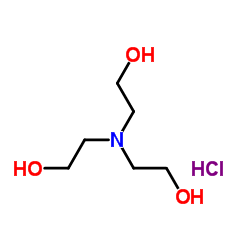Trichlormethine (hydrochloride)

Trichlormethine (hydrochloride) structure
|
Common Name | Trichlormethine (hydrochloride) | ||
|---|---|---|---|---|
| CAS Number | 817-09-4 | Molecular Weight | 240.98600 | |
| Density | N/A | Boiling Point | 156.2ºC at 760 mmHg | |
| Molecular Formula | C6H13Cl4N | Melting Point | 127-130ºC(lit.) | |
| MSDS | Chinese USA | Flash Point | 48.3ºC | |
| Symbol |



GHS05, GHS06, GHS08 |
Signal Word | Danger | |
Use of Trichlormethine (hydrochloride)Trichlormethine hydrochloride is a cytostatic agent in the treatment of cancer and arthritis; shows carcinogenic effects to humans. |
| Name | 2-chloro-N,N-bis(2-chloroethyl)ethanamine,hydrochloride |
|---|---|
| Synonym | More Synonyms |
| Description | Trichlormethine hydrochloride is a cytostatic agent in the treatment of cancer and arthritis; shows carcinogenic effects to humans. |
|---|---|
| Related Catalog | |
| In Vitro | Trichlormethine could be detected at a surface coverage of 0.01 monolayer, which corresponds to 20 ppm (mass/mass) for a soil having a surface area of 2.2 m2/g. TEA, the exhaustive hydrolysis product of trichlormethine, is detected at a surface coverage of 0.001 monolayer, which corresponds to 0.86 ppm[1]. |
| In Vivo | Trichlormethine hydrochloride carries a genetic risk for the postmeiotic stages of spermatogenesis and is responsible for interference in the morphology of sperm heads through its action on spermatocytes. The toxic effects of trichlormethine hydrochloride are found to influence the body weight of mice, to reduce the relative weight of the testes, to damage spermatogenesis in the seminiferous tubules, to be responsible for an appearance of multinucleate cells in the epididymides, and for an increased rate of abnormality of the heads of fully mature spermatozoa[2]. |
| Animal Admin | Mice: The genetic effect of the cytostatic trichlormethine hydrochloride is assessed after a 1-week administration using the dominant lethal mutation test (DLM) and the sperm abnormality test. The dosage is 0.5 mg/kg for 7 consecutive days, an equivalent of the human therapeutic dosage. Simultaneously, the cytostatic's direct toxic effect on male sex organs is assessed[2]. |
| References |
| Boiling Point | 156.2ºC at 760 mmHg |
|---|---|
| Melting Point | 127-130ºC(lit.) |
| Molecular Formula | C6H13Cl4N |
| Molecular Weight | 240.98600 |
| Flash Point | 48.3ºC |
| Exact Mass | 238.98000 |
| PSA | 3.24000 |
| LogP | 2.80680 |
| Storage condition | Poison room |
CHEMICAL IDENTIFICATION
HEALTH HAZARD DATAACUTE TOXICITY DATA
MUTATION DATA
|
| Symbol |



GHS05, GHS06, GHS08 |
|---|---|
| Signal Word | Danger |
| Hazard Statements | H300-H314-H351 |
| Precautionary Statements | P264-P280-P305 + P351 + P338-P310 |
| Personal Protective Equipment | Eyeshields;Faceshields;full-face particle respirator type N100 (US);Gloves;respirator cartridge type N100 (US);type P1 (EN143) respirator filter;type P3 (EN 143) respirator cartridges |
| Hazard Codes | T+: Very toxic;Xi: Irritant; |
| Risk Phrases | R26/27/28;R33;R40 |
| Safety Phrases | S23-S24/25 |
| RIDADR | UN 2928 6.1/PG 1 |
| WGK Germany | 3 |
| RTECS | YE2800000 |
| Packaging Group | II |
| Hazard Class | 6.1(a) |
| HS Code | 2921199090 |
|
~94% 
Trichlormethine... CAS#:817-09-4 |
| Literature: Singh, Ashutosh S.; Sun, Shih-Sheng Journal of Organic Chemistry, 2012 , vol. 77, # 4 p. 1880 - 1890 |
|
~92% 
Trichlormethine... CAS#:817-09-4 |
| Literature: Ichikawa, Satoshi; Ueno, Hideaki; Sunadome, Takuya; Sato, Kousuke; Matsuda, Akira Organic Letters, 2013 , vol. 15, # 3 p. 694 - 697 |
| Precursor 2 | |
|---|---|
| DownStream 9 | |
| HS Code | 2921199090 |
|---|---|
| Summary | 2921199090 other acyclic monoamines and their derivatives; salts thereof VAT:17.0% Tax rebate rate:9.0% Supervision conditions:none MFN tariff:6.5% General tariff:30.0% |
|
Identification of the nitrogen-based blister agents bis(2-chloroethyl)methylamine (HN-2) and tris(2-chloroethyl)amine (HN-3) and their hydrolysis products on soil using ion trap secondary ion mass spectrometry.
J. Mass Spectrom. 35(12) , 1460-9, (2000) The nitrogen blister agents HN-2 (bis(2-chloroethyl)methylamine) and HN-3 (tris(2-chloroethyl)amine) were directly analyzed on the surface of soil samples using ion trap secondary ion mass spectrometr... |
|
|
Ameliorative effect of DRDE 07 and its analogues on the systemic toxicity of sulphur mustard and nitrogen mustard in rabbit.
Hum. Exp. Toxicol. 29(9) , 747-55, (2010) Despite extensive research efforts, there is no unanimous approval of any animal model to evaluate the toxicity of sulphur mustard [SM; bis (2-chloroethyl) sulphide] or nitrogen mustard [HN-3; tris-(2... |
|
|
Carcinogenicity of trichloromethine hydrochloride (TS-160 Spofa) and morphological damage after its intraamniotic injection.
Neoplasma 28(5) , 565-74, (1981) The cytostatic TS-160 (trichloromethine hydrochloride, tris-/2-chloroethyl/amine hydrochloride) was injected subcutaneously into SPF Wistar rats of both sexes. After all doses used, spindle-cell or ev... |
| Trichlormethin |
| Sinalost |
| Lekamin |
| Hn3 hcl |
| Trimustine |
| tris(2-chloroethyl)ammonium hydrochloride |
| EINECS 212-442-3 |
| MFCD00012520 |
| 2-chloro-N,N-bis(2-chloroethyl)ethanamine hydrochloride |
| 2,2',2''-Trichlortriethylamin-hydrochlorid |
| HN3 hydrochloride |
| Tris(2-chloroethyl)amine hydrochloride |
| Trillekamin |
| Trimitan |
| trichlormethine |
| tris(2-chloro-ethyl)amine hydrochloride salt |
| Trichlormethine (hydrochloride) |


 CAS#:31295-54-2
CAS#:31295-54-2 CAS#:280-57-9
CAS#:280-57-9 CAS#:104-19-8
CAS#:104-19-8 CAS#:140-31-8
CAS#:140-31-8 CAS#:107-20-0
CAS#:107-20-0 CAS#:63915-60-6
CAS#:63915-60-6 CAS#:84928-99-4
CAS#:84928-99-4 CAS#:98545-15-4
CAS#:98545-15-4![2-[bis(2-sulfanylethyl)amino]ethanethiol structure](https://image.chemsrc.com/caspic/184/4201-86-9.png) CAS#:4201-86-9
CAS#:4201-86-9